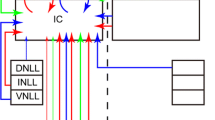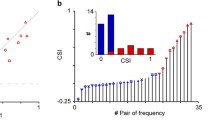Summary
Tone bursts produced bands of selective 2-[14C]-deoxyglucose labelling in the inferior colliculus (IC) of the awake monkey. Low tone frequencies produced labelling in dorsal regions and high tone frequencies produced labelling in ventral regions. The position of the bands coincided with the position of a single unit with a characteristic frequency, which was the same as the frequency producing the labelling. These findings indicate that the bands of labelling represent iso-frequency contours in IC. The iso-frequency contours extended across most of the nucleus and were oriented from dorsomedially to ventro-laterally at 20–30° from the horizontal and became more vertical anteriorly. The width of the contours was as narrow as 200 μm, suggesting that the contours might represent 2 or 3 overlapping cellular laminae.
Similar content being viewed by others
References
Aitkin LM, Webster WR, Veale JL, Crosby DC (1975) Inferior colliculus. I. Comparison of response properties of neurons in the central, pericentral and external nuclei of the adult cat. J Neurophysiol 38: 1196–1207
Berman AL (1968) The brain of the cat. A cytoarchitectonic atlas with stereotaxic coordinates. The University of Wisconsin Press, Madison
Fitzpatrick KA (1975) Cellular architecture and topographic organization of the inferior colliculus of the squirrel monkey. J Comp Neurol 164: 185–208
Fitzpatrick KA, Imig TJ (1982) Organizations of auditory connections: The primate auditory cortex. In: Woolsey CN (ed) Multiple auditory areas, Vol 3. Humana Press, New Jersey, pp 71–110
Geniec P, Morest DK (1971) The neural architecture of the human posterior colliculus. Acta Otolaryngol Suppl 295: 1–33
Gallistel CR, Piner CT, Allen TO, Adler NT, Yadin E, Negin M (1982) Computer assisted analysis of 2-DG autoradiographs. Neurosci Behav Revs 6: 409–420
Goldberg JM, Moore RY (1967) Ascending projections of the lateral lemniscus in the cat and monkey. J Comp Neurol 129: 143–156
Imig TJ, Ruggero MA, Kitzes LM, Javel E, Brugge JF (1977) Organization of auditory cortex in the owl monkey (Aotus trivirgatus). J Comp Neurol 171: 111–128
Merzenich MM, Reid MD (1974) Representation of the cochlea in the inferior colliculus of the cat. Brain Res 77: 397–415
Morest DK, Oliver DL (1984) The neuronal architecture of the inferior colliculus in the cat: Defining the functional anatomy of the auditory midbrain. J Comp Neurol 222: 209–236
Oliver DL, Morest DK (1984) The central nucleus of the inferior colliculus in the cat. J Comp Neurol 222: 237–264
Rockel AJ, Jones EG (1973a) The neural organization of the inferior colliculus of the cat. I. The central nucleus. J Comp Neurol 147: 11–60
Rockel AJ, Jones EG (1973b) The neural organization of the inferior colliculus in the cat. II. The pericentral nucleus. J Comp Neurol 149: 301–334
Ryan A, Miller J (1977) Effects of behavioral performance on single-unit firing patterns in inferior colliculus of the Rhesus monkey. J Neurophysiol 40: 943–956
Ryan A, Miller J (1978) Single unit responses in the inferior colliculus of the awake and performing Rhesus monkey. Exp Brain Res 32: 389–407
Semple MN, Aitkin LM (1979) Representation of sound frequency and laterality by units in the central nucleus of cat inferior colliculus. J Neurophysiol 42: 1626–1639
Servière J, Webster WR, Calford MB (1984) Iso frequency labelling revealed by a combined 2-[14C]-deoxyglucose, electrophysiological and horseradish peroxidase study of the inferior colliculus of the cat. J Comp Neurol (in press)
Sokoloff L (1977) Relation between physiological function and energy in the central nervous system. J Neurochem 29: 13–26
Sokoloff L (1982) The radioactive deoxyglucose method. In: Agranoff BW, Aprison MH (eds) Advances in Neurochemistry, Vol 4. Plenum Press, New York, pp 1–82
Strominger NL (1973) The organization and distribution of the dorsal and intermediate acoustic striae in the Rhesus monkey. J Comp Neurol 147: 209–234
Strominger NL (1978) The anatomical organization of the primate auditory pathway. In: Norback CR (ed) Sensory systems of primates. Plenum Press, New York, pp 53–90
Strominger NL, Strominger AI (1971) Ascending brain stem projections of the antero-ventral cochlear nucleus in the rhesus monkey. J Comp Neurol 143: 217–242
Webster WR, Servière J, Crewther D, Crewther S (1983) Isofrequency contours in the inferior colliculus of the awake monkey: A combined 2-[14C]-deoxyglucose and electrophysiological study. In: Webster WR, Aitkin LM (eds) Mechanisms of hearing. Monash University Press, Clayton, pp 149
Author information
Authors and Affiliations
Additional information
Supported by research grants from the National Health and Medical Research Council of Australia and the Australian Research Grants Scheme
Rights and permissions
About this article
Cite this article
Webster, W.R., Servière, J., Crewther, D. et al. Iso-frequency 2-DG contours in the inferior colliculus of the awake monkey. Exp Brain Res 56, 425–437 (1984). https://doi.org/10.1007/BF00237983
Received:
Accepted:
Issue Date:
DOI: https://doi.org/10.1007/BF00237983




